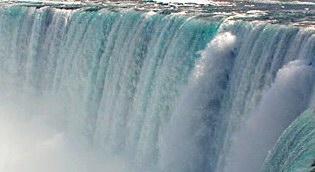|
|
New York - Buffalo - Points of Interest (Midtown)
 (South) (South) The BUFFALO POTTERY, NE. corner of Seneca St. and Hayes Place, manufactures solid-color vitreous china, which it originated.
The LARKIN BUILDING, 680 Seneca St., built in 1904-5, was designed by Frank Lloyd Wright. The location of this office structure suggested a plan in which the interior would be protected from the noise, grime, and odors of adjoining factories, refineries, and railroads. The five floors, occupied by the Larkin store and mail order divisions, look into a deep, narrow skylighted court, which contains the desks of the executives. The outer windows are doubly glazed and hermetically sealed. The building employed one of the first installations of air-conditioning, and interior noise reverberation was done away with by one of the first installations of acoustically absorbent material. All interior furnishings are of steel—one of the first such experiments— and were designed by Wright as an integral part of the building. Chairs are supported on swinging brackets to facilitate floor-cleaning. Adequate artificial lighting is assured by specially designed fixtures. The top story and the outdoor roof terraces provide for employee recreation.
Omitting any reflections of historical architectural styles, Wright achieved a clifflike red brick mass of great dignity and interest, entirely in terms dictated by the structural materials and the internal arrangements. The great corner blocks enclose skylighted stair towers; the simple side wing contains the entrance vestibule and employees' restrooms.
The NATIONAL ANILINE AND CHEMICAL PLANT, Abbott Road at Buffalo River, produces dyes and dyestuff of the aniline type, medicines, tanning materials, synthetic resins, and perfumes.
The REPUBLIC STEEL PLANT, 475 Abbott Road, is the third largest producer of steel in the United States and the largest producer of alloy and special steels in the world. Its products range from carpet tacks to pig iron, and include steel for automobiles, lockers, and a variety of other articles.
The BUFFALO BOTANICAL GARDENS, South Park Ave. and McKinley Parkway, house the city's collection of rare plants. A fall chrysanthemum show and seasonal exhibits of native flora are held annually.
The FORD MOTOR PLANT, Fuhrman Blvd., foot of Ohio St., an assembly unit, has a capacity of 400 cars a day.
The BUFFALO HARBOR, Buffalo River, with a water front of 37 miles extending cast and west from the south end of Michigan Ave., western terminus of the State Barge Canal and eastern terminus of Great Lakes shipping, presents a superb panorama of commercial and industrial Buffalo, with smokestacks of the Lackawanna plant of the Bethlehem Steel Company to the left, and the elephantine grain elevators, graindusted in mist or sun, to the right. Noisy switch-engines back produceladen freight cars to the doors of grim warehouses that line the many slips. Fussy tugs churn the harbor waters and dash spray over the breakwall from rough Lake Erie beyond, where the Coast Guard station, white and neat, sits at the foot of the old lighthouse with its mooing foghorn. Passenger and freight boats constantly arrive and depart. Tugs with strings of barges in tow form an almost unbroken procession out of the Barge Canal. In Winter, with shipping tied up and trade stilled for the season, the lethargic scene suggests mighty forces in hibernation. The panorama has been reproduced in etchings by Joseph Pennell.
|
|
This website is created and designed by Atlantis International, 2006
This is an unofficial website with educational purpose. All pictures, and trademarks are the property of their respective owners and may not be reproduced for any reason whatsoever. If proper notation of owned material is not given please notify us so we can make adjustments. No copyright infringement is intended.

